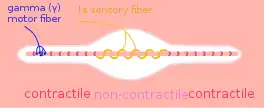Intrafusal muscle fiber
| Intrafusal muscle fiber | |
|---|---|
 A muscle spindle, with γ motor and Ia sensory fibers | |
| Details | |
| Part of | Skeletal muscle |
| Function | Proprioception |
| Identifiers | |
| Latin | myofibra intrafusalis |
| TH | H3.03.00.0.00012 |
| Anatomical terms of microanatomy | |
Intrafusal muscle fibers are skeletal muscle fibers that serve as specialized sensory organs (proprioceptors).[1][2] They detect the amount and rate of change in length of a muscle.[1] They constitute the muscle spindle,[2] and are innervated by both sensory (afferent) and motor (efferent) fibers.[3]
Intrafusal muscle fibers are not to be confused with extrafusal muscle fibers, which contract, generating skeletal movement and are innervated by alpha motor neurons.[4]
Structure
Types
There are two types of intrafusal muscle fibers: nuclear bag fibers and nuclear chain fibers.[3] They bear two types of sensory ending, known as annulospiral and flower-spray endings. Both ends of these fibers contract, but the central region only stretches and does not contract.
Intrafusal muscle fibers are walled off from the rest of the muscle by an outer connective tissue sheath consisting of flattened fibroblasts and collagen.[5] This sheath has a spindle or "fusiform" shape, hence the name "intrafusal".[2]
Innervation
They are innervated by gamma motor neurons and beta motor neurons.[3] Gamma efferents from small multipolar neurons from anterior gray column innervate it. These form a part of neuromuscular spindles.
Function
Intrafusal muscle fibers detect the amount and rate of change in muscle length.[1] It is by the sensory information from gamma motor neurons and beta motor neurons that an individual is able to judge the position of their muscles.[4]
See also
References
- 1 2 3 Casagrand, Janet (2008) Action and Movement: Spinal Control of Motor Units and Spinal Reflexes. University of Colorado, Boulder.
- 1 2 3 Falkel, LORI (January 1, 2007), Cooper, Cynthia (ed.), "Chapter 4 - Tissue-Specific Exercises for the Upper Extremity", Fundamentals of Hand Therapy, Saint Louis: Mosby, pp. 53–72, doi:10.1016/b0-32-303386-5/50007-2, ISBN 978-0-323-03386-2, retrieved December 21, 2020
- 1 2 3 Burke, David (January 1, 2014), "Fusimotor System", Reference Module in Biomedical Sciences, Elsevier, doi:10.1016/b978-0-12-801238-3.00249-x, ISBN 978-0-12-801238-3, retrieved December 21, 2020
- 1 2 Johns, Paul (January 1, 2014), Johns, Paul (ed.), "Chapter 4 - Sensory and motor pathways", Clinical Neuroscience, Churchill Livingstone, pp. 49–59, doi:10.1016/b978-0-443-10321-6.00004-7, ISBN 978-0-443-10321-6, retrieved December 21, 2020
- ↑ Mancall, Elliott L; Brock, David G, eds. (2011). "Chapter 2 - Overview of the Microstructure of the Nervous System". Gray's Clinical Neuroanatomy: The Anatomic Basis for Clinical Neuroscience. Elsevier Saunders. pp. 29–30. ISBN 978-1-4160-4705-6.
External links
- Histology at ucsd.edu
- Histology at umdnj.edu
- "Chapter 1: The Muscle Spindle and the Central Nervous System". Neuromuscular Reeducation with Electromyometric Feedback (PDF). Advanced Therapy Institute. Retrieved November 30, 2013.